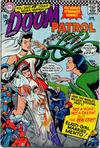
One of the great things about not reading particular titles when they are first released is that they will be there waiting for you whenever you may be ready. After reading some good reviews about this series over at CBR, I decided to track it down and picked up issues #1 through #20 from Lone Star Comics for well under a buck a pop.
After reading the first dozen or so issues I am pretty impressed. I have always been a fan of John Ostrander and his mixture of witty banter and consciously slow character development here is particularly strong. Right off the bat, I was much of a fan of the artwork by the team of McDonnell and Kesel, as it seemed so 'Generic Late 80s DC'. What really struck me was the weakness of the covers - with the exception of Chaykin's kick ass cover for #2 and the cool Deadshot cover for #6 - and the varying quality of the art on some of the characters. The squarehead look given to both Bronze Tiger and Colonel Flag looks like its out of a second tier fanzine.
 The cast of characters, for the most part is quite good - I find Flag's attempts to channel his inner Fury to be quite endearing. Of the villains, Ostrander seems to have the most fun with Captain Boomerang's 'French Quarter Cad' routine. As a sucker for all thing Charlton - it's great to see Nightshade back in action. On the downside, I am not sure where they are going with the 'Deadshot pulling his shots' bit, and I find the Enchantress to be a bit of a one note character. I hope they resolve both of those issues.
The cast of characters, for the most part is quite good - I find Flag's attempts to channel his inner Fury to be quite endearing. Of the villains, Ostrander seems to have the most fun with Captain Boomerang's 'French Quarter Cad' routine. As a sucker for all thing Charlton - it's great to see Nightshade back in action. On the downside, I am not sure where they are going with the 'Deadshot pulling his shots' bit, and I find the Enchantress to be a bit of a one note character. I hope they resolve both of those issues.As for the stories, the first few issues are great as the reader gets to follow the Squad on its first few adventures. I must admit to feeling a bit lost at first, not having read the Secret Origins issue that is incessantly referenced in the editor's notes, but quickly got me bearings. I particularly liked the multi-issue sojourn to the Soviet Union as it has a real 'Remember the 80s?' Cold War vibe to it. The infiltration of Belle Reve by Batman was fun, but his whole vendetta against the Squad - which was revisited in the JLI issue - has not been explained to my satisfaction. I could have also lived without the Millennium issue. Back in the day, I went out of my way not to be millennium books as my relatively thin wallet was pissed at DC for interrupting our regularly scheduled programming. Funnily enough - I own a page of Norm Breyfogle art from the Millennium Detective Comics issue featuring Batman and Jim Corrigan.

Overall the series is pretty consistently strong, thanks to Ostrander's strengths as a storyteller, and as I finished each issue I looked forward to picking up the next. I am even starting to better appreciate the artwork, which improved once Bob Lewis started on inks. I believe that much of the problem has to do with the quality (or lack thereof) of paper used by DC at the time, it pretty much kills most artwork. I am looking forward to finishing my run up to number 20, but I will reserve judgment about tracking down any more issues until then. At this stage, I am just happy to be reading some fresh stories that I missed the first time around for less money than they would have cost me at the time.








